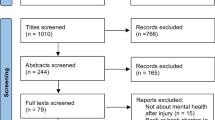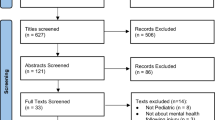Summary
Although research on the psychological impact of injury is in its infancy, this article reviews relevant literature focusing on post-injury emotional response, self-esteem, and the effect of mood disturbance on rehabilitation from sport injury. Injury is often accompanied by depression, tension, anger and low self-esteem, particularly in competitive, seriously injured athletes. Mood disturbance seems to relate to the athlete’s perceived progress in rehabilitation and has been shown to negatively relate to attendance at rehabilitation sessions.
This article also describes how the Emotional Responses of Athletes to Injury Questionnaire (ERAIQ) serves as a guide for the initial interview of an injured athlete. Interventions such as positive self-talk, relaxation, goal setting and healing imagery, all used by a faster healing group of athletes, and although not well researched, seem appropriate to assist athletes in coping with injury. Modelling interventions during injury rehabilitation have also been shown to have a positive effect on rehabilitation and should be used. These relationships are described in more depth and in the context of a theoretical model. Directions for future research are suggested.
Similar content being viewed by others
References
Boyce WT, Sobolewski S. Recurrent injuries in school children. Am J Dis Child 1989; 143: 338–42
Murray DG. High school injury surveillance systems. Proceedings from Conference on Sports Injuries in Youth: Surveillance Strategies. 1991 Apr 8–9. Bethesda (MD): National Institutes of Health, 1992 Nov: 39–47
Cantu RC, Mueller RC. Catastrophic injuries and fatalities in high school and college sports. Med Sci Sports Exerc 1990; 22: 737–74
Reid DC, Saboe L. Spine fractures in winter sports. Sports Med 1989; 7: 393–9
Smith AM, Milliner EK. The risk of suicide in athletes. J Athlet Training 1994; 29(9): 337–41
Smith AM, Scott SG, O’Fallon WM, et al. The emotional response of athletes to injury. Mayo Clin Proc 1990; 65: 38–50
Smith AM, Stuart MJ, Wiese-Bjornstal DM, et al. Competitive athletes: pre and post injury mood state and self-esteem. Mayo Clin Proc 1993; 68: 939–49
Smith RE, Smoll FL, Ptacek JT. Conjunctive moderator variables in vulnerability and resiliency research: life stress, social support and coping skills, and adolescent sport injuries. J Pers Soc Psychol 1990; 58: 360–70
Andersen MB, Williams JM. A model of stress and athletic injury: prediction and prevention. J Sport Exerc Psychol 1988; 10: 294–306
Williams JM, Roepke N. Psychology of injury and injury rehabilitation. In: Singer RN, Murphey M, Tennant LK, editors. Handbook of research on sport psychology. New York: Mac-Millian, 1993: 815–39
Eldridge WE. The importance of psychotherapy for athletic-related orthopedic injuries among adults. Int J Sports Psychol 1983; 14: 203–11
Little JC. The athletes’ neurosis: a deprivation crisis. Acta Psychiatr Scand 1969; 45: 187–97
Little JC. Neurotic illness in fitness fanatics. Psychiatr Ann 1979, 9: 148–52
Scott SG. Current concepts in the rehabilitation of the injured athletes. Mayo Clin Proc. 1984; 59: 83–90
Smith AM, Scott SG, Wiese DM. The psychological effects of sports injuries: coping. Sports Med 1990; 9: 352–69
Shelbourne KD, Foulk DA. Timing of surgery in acute anterior cruciate ligament tears on the return of quadriceps muscle strength after reconstruction using an autogenous patellar graft. Am J Sports Med 1995; 23: 686–9
Grove JR, Stewart RML, Gordon S. Emotional reactions of athletes to knee rehabilitation. Paper presented at the Annual Meeting of the Australian Sports Medicine Federation; 1990 Oct; Alice Springs
LaMott EE. The anterior cruciate ligament injured athlete: the psychological process [unpublished doctoral dissertation]. Minneapolis: University of Minnesota, 1994
Morrey, MA. Predicting injury recovery is a function of affect and pain perception in athletes who have undergone anterior cruciate ligament reconstruction surgery: an exploratory study [abstract]. Association for the Advancement of Applied Sport Psychology (AAASP) Conference. Williamsburg (VA): AAASP, 1996
Duda JL, Smart AE, Tappe MK. Predictors of adherence in the rehabilitation of athletic injuries: an application of personal investment theory. J Sport Exerc Psychol 1989; 11: 367–81
Fisher AC, Domm MA, Wuest DA. Adherence to sports injury rehabilitation programs. Physician Sports Med 1988; 16: 47–51
Lampton CC, Lambert ME, Yust R. The effects of psychological factors in sports medicine rehabilitation adherence. J Sports Med Phys Fitness 1993; 33: 292–9
Cassem MH, Hackett TP. Psychiatric consultations in a coronary care unit. Ann Intern Med 1971; 75: 9–14
Kuebler-Ross E. On death and dying. New York: Macmillian, 1969
Carmen L, Zerman JL, Blaine GB. The use of the Harvard psychiatric service by athletes and non-athletes. Ment Hyg 1968; 52: 134–7
Pierce RA. Athletes in psychotherapy: how many, how come? J Am Coll Health Assoc 1969; 17: 244–9
Linder DE, Pillow DR, Reno RR. Shrinking jocks: derogation of athletes who consult a sports psychologist. J Sport Exerc Psychol 1989; 11: 270–80
Rohe DE. Psychological aspects of rehabilitation. In: DeLisa JA, editor. Rehabilitation medicine: principles and practice. Philadelphia: Lippincott, 1988: 66–82
Brewer BW. Review and critique of models of psychological adjustment to athletic injury. J Appl Sport Psychol 1994; 6: 87–100
Lynch GP. Athletic injuries and the practicing sport psychologist: practical guidelines for assisting athletes. Sport Psychol 1988; 2: 161–7
Pederson P. The grief response and injury: a special challenge for athletes and athletic trainers. Athlet Training 1986; 21: 312–4
Leddy MH, Lambert MJ, Ogles BM. Psychological consequences of athletic injury among high level competition. Res Q Exerc Sport 1994; 65: 349–54
McDonald SA, Hardy CJ. Affective response patterns of the injured athlete: an exploratory analysis. Sport Psychol 1990; 4: 261–74
Weiss MR, Troxel RK. Psychology of the injured athlete. Athlet Training 1986; 21: 104–9, 154
Chan CS, Grossman HY. Psychological effects of running loss on consistent runners. Percept Mot Skills 1988; 66: 875–83
Brewer BW, Linder DE, Phelps CM. Situational correlates of emotional adjustment to athletic injury. Clin J Sport Med 1995; 5: 241–5
Pearson L, Jones G. Emotional effects of sports injuries: Implications for physiotherapists. Physiotherapy 1992; 78: 762–70
Connelly SL. Injury and self-esteem: a test of Sonestrom and Morgan’s model[Masters thesis]. Vermillion: South Dakota State University, 1991
Wiese DM, Weiss MR, Yukelson DP. Sport psychology in the training room: a survey of athletic trainers. Sport Psychol 1991; 5: 15–24
Gordon S, Milios D, Grove JR. Psychological aspects of the recovery process from sport injury: the perspective of sport physiotherapists. Aust J Sci Med Sport 1991; 23: 53–60
Brewer BW, Van Raalte JL, Linder DE. Role of the sport psychologist in treating injured athletes: a survey of sports medicine providers. J Appl Sport Psychol 1991; 3: 183–90
Brewer BW, Jeffus KE, Petitpas AJ, et al. Perceptions of psychological interventions in the context of sport injury rehabilitation. Sport Psychol 1994; 8(2): 176–88
Flint FA. The psychological effects of modeling in athletic injury rehabilitation[doctoral dissertation]. Eugene: University of Oregon, 1991
Davis JO. Sports injuries and stress management: an opportunity for research. Sport Psychol 1991; 5: 175–82
Ievleva L, Orlick T. Mental links to enhanced healing: an exploratory study. Sport Psychol 1991; 5: 25–40
LaMott E, Petlichkoff LM. Psychological factors and the injured athlete: an educational approach. Presented at the Association for the Advancement of Applied Sports Psychology; 1990 Sep 14; San Antonio
Wiese-Bjornstal DM, Smith AM, LaMott EE. A model of psychological response to athletic injury and rehabilitation. Athletic Training; Sports Health Care Perspectives 1995; 1: 16–30
McNair DM, Lorr M, Droppleman LF. Profile of mood states. San Diego (CA): Educational and Industrial Testing Service, 1971
Rosenberg M. Society and the adolescent self-image. Princeton (NJ): Princeton University Press, 1968
Morgan WP. Psychological characteristics of the elite long distance runner. Ann NY Acad Sci 1977; 301: 382–403
Dishman RK. Medical psychology in exercise and sport. Med Clin North Am 1985; 69: 123–42
Lorr M, McNair DM. Manual for the profile of mood states-bipolar form. San Diego: Educational and Industrial Testing Service, 1984
Sonestrom RJ, Morgan WP. Exercise and self-esteem: rationale and model. Med Sci Sports Exerc 1989; 21: 329–37
McGowan RW, Pierce EF, Williams M, et al. Athletic injury and self-diminution. J Sports Med Phys Fitness 1994; 34: 299–304
Dugan DO. Death and dying: emotional, spiritual and ethical support for patients and families. J Psychosoc Nurs Ment Health Serv 1987; 25: 21–9
Durant RH, Prendergrast RA, Donner J, et al. Adolescents attrition from school sponsored sports. Am J Dis Child 1991; 145: 1119–23
Lipman AG. Medications in the treatment of pain and injury. In: Heil J, editor. Psychology of sport injury. Champaign (IL): Human Kinetics, 1993: 281–90
Meyers MC, Bourgeois AE, Stewart S, et al. Predicting pain response in athletes: development and assessment of the sports inventory for pain. J Sport Exerc Psychol 1992; 114: 249–61
Lewis L, LaMott EE. Psychosocial aspects of the injury response in professional football: an exploratory study. Presented at the annual meeting for the Association for the Advancement of Applied Sport Psychology; 1992 Oct; Colorado Springs
Baillie H. Understanding retirement from sports: therapeutic ideas for helping athletes in transition. Couns Psychol 1993; 21: 399–41
Kleiber DA, Brock SC. The effect of career ending injuries on the subsequent well-being of elite college athletes. Sociol Sport J 1992; 9: 70–5
Rotella RJ, Ogilvie BC, Perrin DH. The malingering athlete: psychological considerations. In: Pargman D, editor. Psychological bases of sports injuries. Morgantown: Fitness Information Technology, Inc., 1993: 85–97
Heil J, editor. Psychology of sport injury. Champaign (IL): Human Kinetics, 1993
Fisher AC, Scriber KC, Matteny ML, et al. Enhancing athletic injury rehabilitation adherence. J Athlet Training 1993; 28: 312–8
Shaffer SM. Attributions and self-efficacy as predictors of rehabilitative success[Masters thesis]. University of Illinois: Champaign-Urbana, 1991
Daly JM, Brewer BW, VanRaalte JL, et al. Cognitive appraisal, motional adjustment and adherence to rehabilitation following knee surgery. J Sport Rehab 1995; 4: 22–30
Greenspan MJ, Feltz DL. Psychological interventions with athletes in competitive situations: a review. Sport Psychol 1989; 3: 219–36
Wiese DM, Weiss MR. Psychological rehabilitation and physical injury: implications for the sportsmedicine team. Sport Psychol 1987; 1: 318–30
Durso-Cupal DD. The efficacy of guided imagery for recovery from anterior cruciate ligament (ACL) replacement. J Appl Sport Psychol (AAASP Abstracts) 1996 Oct; 8 Suppl.: S56
Lindenfeld TN, Noyes FR, Marshal MT. Components of injury reporting systems chapter 15. Am J Sports Med 1988; 16: S69–80
Smith AM. Physical and psychosocial predictors of injury in male high school hockey players[Ph.D. thesis]. University of Minnesota: Minneapolis 1995
Stuart MJ. Principles of ice hockery research. J Appl Sport Psychol (AAASP Abstracts) 1996 Oct; 8 Suppl.: S40
Rice SG. Epidemiology and mechanism of sports injuries. In: Teitz CC, editor. Scientific foundations of sports medicine. Toronto: Decker, 1989: 3–23
Stuart MJ, Smith AM. Injuries in junior ice hockey. Am J Sports Med 1995; 23: 458–61
Stuart MJ, Smith AM, Nieva JG, et al. Injuries in youth hockey: surveillance strategy. Mayo Clin Proc 1995; 70: 350–6
Wiese-Bjornstal DM, Smith AM. Counseling strategies for enhanced recovery of inured athletes within a team approach. In: Pargman D, editor. Psychological bases of sports injuries. Morgantown: Fitness Information Technology, Inc., 1993: 149–82
Udry EM. Coping and social support among injured atheltes. J Appl Sport Psychol (AAASP Abstracts) 1996 Oct; 8 Suppl.: S56
Bianco TM, Orlick T. Social support influences on recovery from sports injury. J Appl Sport Psychol (AAASP Abstracts) 1996 Oct; 8 Suppl.: S57
Author information
Authors and Affiliations
Rights and permissions
About this article
Cite this article
Smith, A.M. Psychological Impact of Injuries in Athletes. Sports Med 22, 391–405 (1996). https://doi.org/10.2165/00007256-199622060-00006
Published:
Issue Date:
DOI: https://doi.org/10.2165/00007256-199622060-00006




